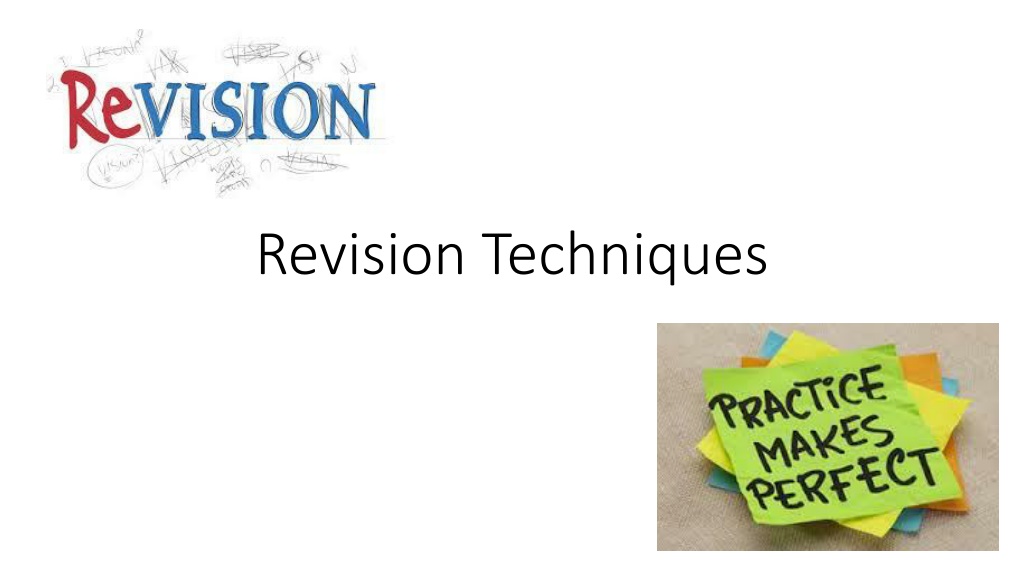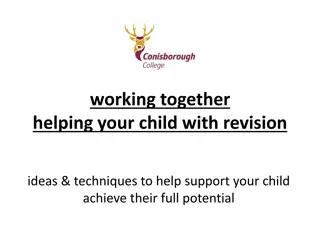Effective Revision Techniques for Better Learning
Explore two powerful revision techniques - the Cornell System and Mind Mapping - to enhance your learning and retention. The Cornell System emphasizes note-taking structure, reflection, and regular reviews, while Mind Mapping encourages creative visualization, association, and organization of information. These methods can help you study smarter, improve memory recall, and boost exam preparation efficiency.
Download Presentation

Please find below an Image/Link to download the presentation.
The content on the website is provided AS IS for your information and personal use only. It may not be sold, licensed, or shared on other websites without obtaining consent from the author. Download presentation by click this link. If you encounter any issues during the download, it is possible that the publisher has removed the file from their server.
E N D
Presentation Transcript
#1 Cornell System: Suitable for those of you who like writing and learn from your own notes.
Cornell System: Divide your page into 2 columns with the Note Column about twice as wide as the Cue Column. Write notes in full sentences in the Note Column. In the Cue Column put words or questions that relate to that note. Writing questions helps to clarify meanings, reveal relationships, establish continuity, and strengthen memory. Also, the writing of questions sets up a perfect stage for exam-studying later. Cover the note-taking column with a sheet of paper. Then, looking at the questions or cue-words in the question and cue column only, say aloud, in your own words, the answers to the questions, facts, or ideas indicated by the cue-words.
Cornell System Reflect on the material by asking yourself questions, for example: What s the significance of these facts? What principle are they based on? How can I apply them? How do they fit in with what I already know? What s beyond them? Review: Spend at least ten minutes every week reviewing all your previous notes. If you do, you ll retain a great deal for current use, as well as, for the exam.
Mind Mapping Start in the CENTRE of a blank page turned sideways. Why? Because starting in the centre gives your Brain freedom to spread out in all directions and to express itself more freely and naturally. Use an IMAGE or PICTURE for your central idea. Why? Because an image is worth a thousand words and helps you use your Imagination. A central image is more interesting, keeps you focussed, helps you concentrate, and gives your Brain more of a buzz! Use COLOURS throughout. Why? Because colours are as exciting to your Brain as are images. Colour adds extra vibrancy and life to your Mind Map, adds tremendous energy to your Creative Thinking, and is fun!
Mind Mapping CONNECT your MAIN BRANCHES to the central image and connect your second- and third-level branches to the first and second levels, etc. Why? Because your Brain works by association. It likes to link two (or three, or four) things together. If you connect the branches, you will understand and remember a lot more easily. Make your branches CURVED rather than straight-lined. Why? Because having nothing but straight lines is boring to your Brain.
Mind Mapping Use ONE KEY WORD PER LINE. Why Because single key words give your Mind Map more power and flexibility. Use IMAGES throughout. Why Because each image, like the central image, is also worth a thousand words. So if you have only 10 images in your Mind Map, it s already the equal of 10,000 words of notes!
#3 Revision Cards Revision cards are one of the classic study tools, and for good reason they promote studying through active recall, which is one of the practices through which our brains learn most effectively.
Revision cards tips: Make your own: Using pre-made cards can sometimes be useful such as a case where you have an unreasonably high number of facts to learn and you re in a time crunch but in most cases, you ll serve your brain better by making your own flash cards. Mix Pictures and Words: Adding pictures to your cards can make them a lot more memorable. In cognitive psychology, there s a concept called the Picture Superiority Effect, which describes how people tend to remember imagery a lot better than they remember words.
Revision Cards - Tips Use Mnemonic devices to create mental connections: A mnemonic devices is anything that helps you build an association between two pieces of information in your mind. A classic mnemonic that almost everyone knows is ROY G. BIV the acronym that helps you remember the order of the colours in the visual light spectrum. Write only one question per card: you are far less likely to make mistakes this way.
Revision Cards - Tips Say your answers out loud when studying: either talk to yourself, or do it with a study partner it forces you (both) to check and re-check your answers.




























